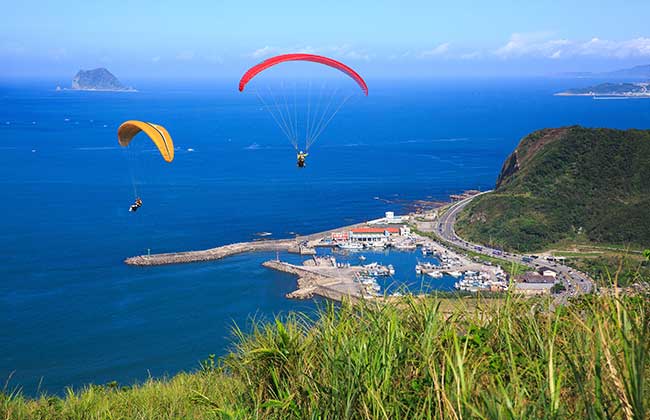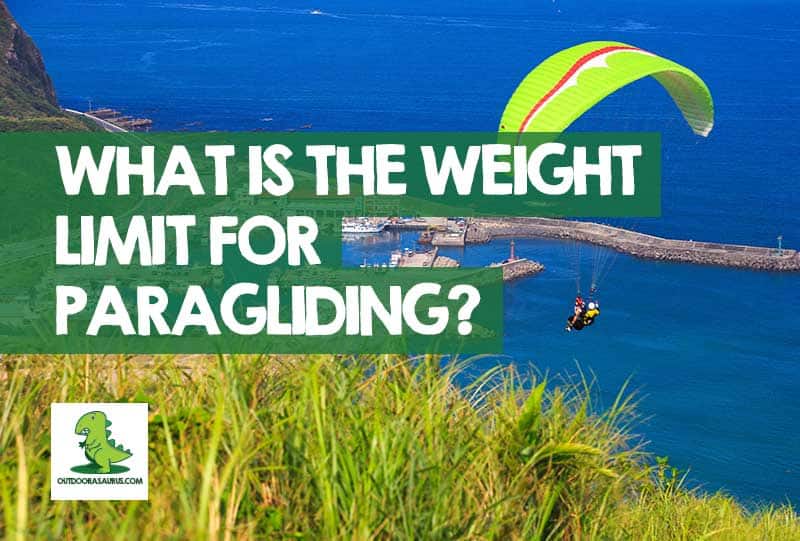There is a lot of conflicting information on paragliding weight limit restrictions. Many people gearing up for a paragliding adventure or wanting to get into the sport as a hobby, question the weight restrictions they see online, being confused by the variance in advice.
What is the weight limit for paragliding?
The weight limit for paragliding is determined by the paraglider itself. Most extra-large paragliders can support up to 120kg (265 pounds) of weight for a single paraglider, including pilot & equipment. For heavier weights, a tandem paraglider can be used as they can support a weight of up to 240kg (529 pounds) maximum including pilot, passenger, and equipment.
Paragliding weight limit advice
Paragliding uses forces of gravity, strong winds, and glider wing power to stay airborne. Therefore, each paraglider of each different size will have its maximum and minimum weight range.
Some single paragliders have been custom-designed to handle heavier loads.
Read on to learn more about how paragliding works, why there are weight limits imposed, and how load restrictions are worked out for each flight.

Reasons for weight limitations when paragliding
Many people don’t understand why there would be a paragliding weight limit. The weight restrictions are for logical and physical reasons.
As mentioned above, paragliding uses wind force and gravity. If you calculate the weight of the paraglider load accurately and don’t overload it, you stand to benefit greatly as you can then be in the air for hours at a time and cover a much greater distance.
The heavier the load in comparison to the wind force, the less air-time you can expect to enjoy and naturally, you won’t be able to travel quite as far a distance.
It is all about the experience for the pilot (and passenger if it is a tandem flight). Longer flights mean more enjoyment for all involved.
What happens if you overload the paraglider?
Many first-timers underestimate the importance of calculating paragliding weight limits and that is why the pilot training pays special attention to this particular topic.
Overloading the paraglider is strongly discouraged.
Not only will this shorten flight time and distance covered, it can also present a number of problems and potential safety risks/dangers for both pilots and passengers.
Below are a few of the dangers/problems associated with overloading a paraglider:
Problems taking off with overloaded paraglider
If a pilot doesn’t pay attention to carefully calculating and adhering to weight limits, taking off might prove difficult. Wind force plays a major role in the process of taking off in a paraglider.
If the wind force isn’t powerful enough to actually lift the weight inside the unit, the glider might not even make it off the ground.
Take off usually happens from a steep hillside or similar as the paraglider has no motor or engine. Taking off is a very similar mechanism to flying a kite.
The pilot positions himself and the glider on a steep incline and waits for the perfect moment to take off and soar.
Only once the wind catches in the glider, the unit can take off. If the weight is too heavy and the winds not strong enough, the glider will probably keep dropping just after the wind catches in the glider.
With powerful gusts (inconsistent flow of wind), the glider may lift off and drop shortly after, which as you can imagine, is not safe or comfortable.
Dropping out of the air mid-flight due to wind loss and overloading
Paragliding requires launching in strong wind and ideal thermic conditions. A glider can carry quite far if the weight of it is supported by the air currents.
Understanding this is key to being a good (and safe) paragliding pilot.
In some instances, paragliders have dropped out of the sky when the wind suddenly stops, or the thermic conditions change and the aircraft is too heavy.
Why do overloaded paragliders drop out of the sky when the wind stops?
Without wind, there is no forward motion which causes the wing to collapse. The weight of the glider and the pull of gravity cause a dropping motion.
A heavy, low glider may simply fall/drop, but lighter gliders fling high enough may be just fine. If the aircraft is high enough when this type of collapse happens, the wing can re-inflate and recover.
Unfortunately, this is not always the case with an overloaded, low flying paraglider.
Crash landings/unsafe landings with overloaded paragliders
Landing safely is a major concern for all paraglider pilots. This is another instance where the weight of the paragliding equipment, the pilot, and any passengers play an important role.
An overloaded paraglider may face certain difficulties on landing. The lighter the load, the easier it will be for the pilot to safely land the unit without damage or injury.
Remember that paragliding uses gravity for take off and landing.
The heavier the paraglider is, the more strain the aircraft may be under, especially if the wind forces are strong.
In these instances, crash landings of varying degrees may happen.
How are paragliding load restrictions calculated?
When paragliding, it is important to calculate your weight correctly to avoid putting yourself (and potentially a passenger) at risk.
How is the safe load capacity of a paraglider calculated?
Instructors and pilots learn early on in their paragliding career to calculate exact limits for each paraglider that they fly, for obvious safety reasons.
Factors that affect weight limitation calculations
Weight and load capacity limitation calculations are based on a number of factors including:
- The local wind and weather conditions on the day.
- Body weight approximations of the pilot (in a solo flight), or pilot and passenger (in a tandem flight).
- Size of the paraglider’s wing (wingspan).
- Weight of all the gear that will be carried by the pilot (in a solo situation), or the pilot and the passenger (in a tandem situation).
An example of the type of load a paraglider can handle and how to calculate it:
If, in ideal wind conditions, a paraglider can support (or has a weight limit of) 120kg (265lbs) and all of your gear comes to 40kg (88lbs), then the passenger and pilot weight combined cannot exceed 80kg (176lbs).
Just from this example, you can see why weight calculations are quite important.
If the pilot weighed in excess of 80kg, he would be better suited using a different paraglider or opting to fly a tandem glider.
Of course, all of this could change depending on the strength/force of the winds on the day of gliding.
When a paraglider pilot and passenger calculate their weight including all of their gear (including full size harness), it is called “all up weight”.
To calculate your all up weight, put on all of your flying gear and rucksack and stand on a scale. This will give you your total weight.
How minimum and maximum weight limits affect paragliding
While overloading is an important factor to pay attention to when paragliding, minimum weight limits should also be considered.
While there is nothing to say you cannot and should not take off if you have an extremely light weight on the glider, it can have a negative impact on the gliding experience.
Being well-loaded, which means closely within the maximum weight limit is preferable to being severely under that weight, and here are a few reasons why:
- Light loads may result in more wing collapses which can be dangerous: Well-loaded wings are less prone to frequent collapses. That being said, while well-loaded wings are more collapse resistant, it’s important to have a careful balance of weight within the recommended limited. This is because a loaded wing will have more energy if/when it collapses which could result in substantial height loss in collapse situations. If you aren’t overloaded, you can assume that you will be able to re-inflate and correct though. Choosing the right paraglider class is therefore quite important.
- Light paragliders may prove difficult to control: A well-loaded or weighted paraglider is easier to control and steer/direct. A pilot uses his body weight and position to manipulate the wing. The lighter the weight, the more “flighty” (in a negative way) the paraglider might be.
- A well-loaded paraglider will have a greater speed with slightly more control: At full speed though, there are risks as the force of air striking the glider may make the wing pucker and cause disruptions in speed while posing safety hazards.
Conclusion
There you have it, now you know what the weight limit for paragliding might be; the weight limits for each paraglider are different.
The actual make-up and design of the paraglider, including the size of the wing (wingspan) will be the major deciding factor on the weight limitations attached to each unit.
It is however important to know what sort of loads you intend to carry with your paraglider so that you can invest in or rent a paraglider that falls within the correct class – with the correct load handling capacity.
Most single paragliders, unless custom-designed, can safely glide with a total weight of up to 120 – 130kg (approximately 265 pounds) whereas tandem paragliders can safely glide with a total weight of up to 240kg (259 pounds).
While this is true, it is important to note that different manufacturers create different size gliders with different handling capacities – as well as special order gliders – so it is best to check with these manufacturers before deciding on the right paraglider for you.

